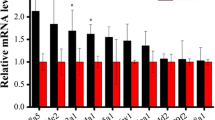Abstract
The insect growth regulator diflubenzuron (DFB), which also inhibits growth of experimental tumors in mice, was studied to determine the influence of in vivo microsomal metabolism on its antitumor activity. DFB inhibits chitin synthesis and growth of imaginal epidermis in insects and suppresses melanogenesis and uptake of nucleosides in mouse melanoma cells, but the means of cell growth regulation and the role of metabolism of DFB in such regulation have not been established. Five daily injections of DFB (total of 4000 mg/kg) into C57BL/6 mice with B16 melanomas induced an acute 11–20% decrease in tumor volume and a 2–3 day increase in the initial tumor volume doubling time (Td), but at mid-treatment tumors regained maximum (control-like) rate of volume increase. Tumors in mice conditioned with a mixed function oxidase inhibitor (CoCl2) and treated with DFB did not decrease in mean volume, but their rate of volume increase was reduced by about 75% and the Td was increased by 4.2 days. In contrast, induction of mixed function oxidase with 3-methylcholanthrene (3-MC) or beta-napthaflavone (B-NF) enhanced the effects of DFB by a factor of 1.5 to 2.0. Therefore, aromatic hydroxylation of DFB may be required for tumor growth regulation. Three metabolites of DFB — two hydroxylated forms and a scission product, 4-chlorophenylurea (CPU), were also tested for tumor growth regulation. CPU was ineffective; a form oxidized at the 3 carbon of the phenyl ring (3-OH-DFB) was only marginally effective; but the 2-carbon form (2-OH-DFB) induced a 24% decrease in mean tumor volume and a 2.4 day increase in Td. Pretreatment with 3-MC and treatment with 2-OH-DFB also resulted in a 24% decrease in tumor volume and a 2.2 day increase in Td, but also reduced tumor volume increase to 20% between the 5th and 10th days after the initial 2-OH-DFB injection, compared to a 125% increase without 3-MC. Further, 3-MC pretreatment caused the otherwise marginally effective 3-OH-DFB to become almost as effective as 2-OH-DFB. These data support our previous report that DFB alters tumor growth and show that mixed function oxidase enhances effects of DFB, 2-OH-DFB and 3-OH-DFB.
Similar content being viewed by others
References
Verloop A, Ferrell CD: Benzoylphenylureas — a new group of larvicides interfering with chitin deposition. Am Chem Soc Mongr 37:237–270, 1977
Maas W, Van Hess R, Grosseurt AC, Deul DH: Benzoylphenylurea insecticides. In: Wegler R (ed) Chemie der Pflanzenschutz und Schädlingsbekämpfungsmittel. Vol. 6, Springer-Verlag, Berlin, Heidelberg, pp 423–469, 1980
Post LC, DeJong BJ, Vincent WR: 1-(2,6-Disubstituted benzoyl)-3-phenylurea insecticides: inhibitors of chitin synthesis. Pestic Biochem Physiol 4:473–483, 1974
Sowa BA, Marks EP: An in vitro system for the quantitative measurement of chitin synthesis in the cockroach: inhibition by TH60–40 and polyoxin D. Insect Biochem 5:855–859, 1975
Deul DH, DeJong BJ, Kortenbach JAM: Inhibition of chitin synthesis by two 1-(2,6-disubstituted benzoyl)-3-phenylurea insecticides. Pestic Biochem Physiol 8:98–105, 1978
DeLoach JR, Meola SM, Mayer RT, Thompson JM: Inhibition of DNA synthesis by diflubenzuron in pupae of the stable fly. Pestic Biochem Physiol 15:172–180, 1981
Meola SM, Mayer RT: Inhibition of cellular proliferation of the imaginal epidermal cells by diflubenzuron in pupae of the stable fly. Science 207:985–987, 1980
Norman JO, Meola SM: Inhibition of melanogenesis in B16-F1 melanoma cells after exposure to diflubenzuron. Antimicrob Agents Chemother 23:313–316, 1983
Mayer RT, Netter KJ, Leising HB, Schachtschabel DO: Inhibition of the uptake of nucleosides in cultured Harding-Passey melanoma cells by diflubenzuron. Toxicology 30:1–6, 1984
Jenkins VK, Mayer RT, Perry RR: Effects of diflubenzuron on growth of malignant melanoma and skin carcinoma tumors in mice. Invest New Drugs 2:19–27, 1984
Willems AGM, Overtaas H, Scherpenisse P, DeLange N, Post LC: Diflubenzuron: intestinal absorption and metabolism in the rat. Xenobiotica 10:103–112, 1980
Tephly TR, Webb C, Trussler P, Kniffen F, Hasegawa E, Piper W: The regulation of heme synthesis related to drug metabolism. Drug Metab Dispos 1:259–266, 1973
Maines MD, Kappas A: Cobalt stimulation of heme degradation. J Biol Chem 250:4171–4177, 1975
Testa B, Jenner P: Drug metabolism, chemical and biochemical aspects: induction of drug metabolizing enzymes. Marcel Dekker, Incorporated, New York, p 329, 1976
Schabel Jr FW, Griswold Jr DP, Corbett TH, Laster Jr WR, Lloyd HH, Rose WC: Variable responses of advanced solid tumors of mice treated with anticancer drugs. In: Fidler IJ, White RJ (eds) Design of Models for Testing Cancer Therapeutic Agents. Von Nostrond Reinhold Company, New York, pp 95–113, 1981
Author information
Authors and Affiliations
Rights and permissions
About this article
Cite this article
Jenkins, V.K., Perry, R.R., Ahmed, A.E. et al. Role of metabolism in effects of diflubenzuron on growth of B16 melanomas in mice. Invest New Drugs 4, 325–335 (1986). https://doi.org/10.1007/BF00173505
Issue Date:
DOI: https://doi.org/10.1007/BF00173505




